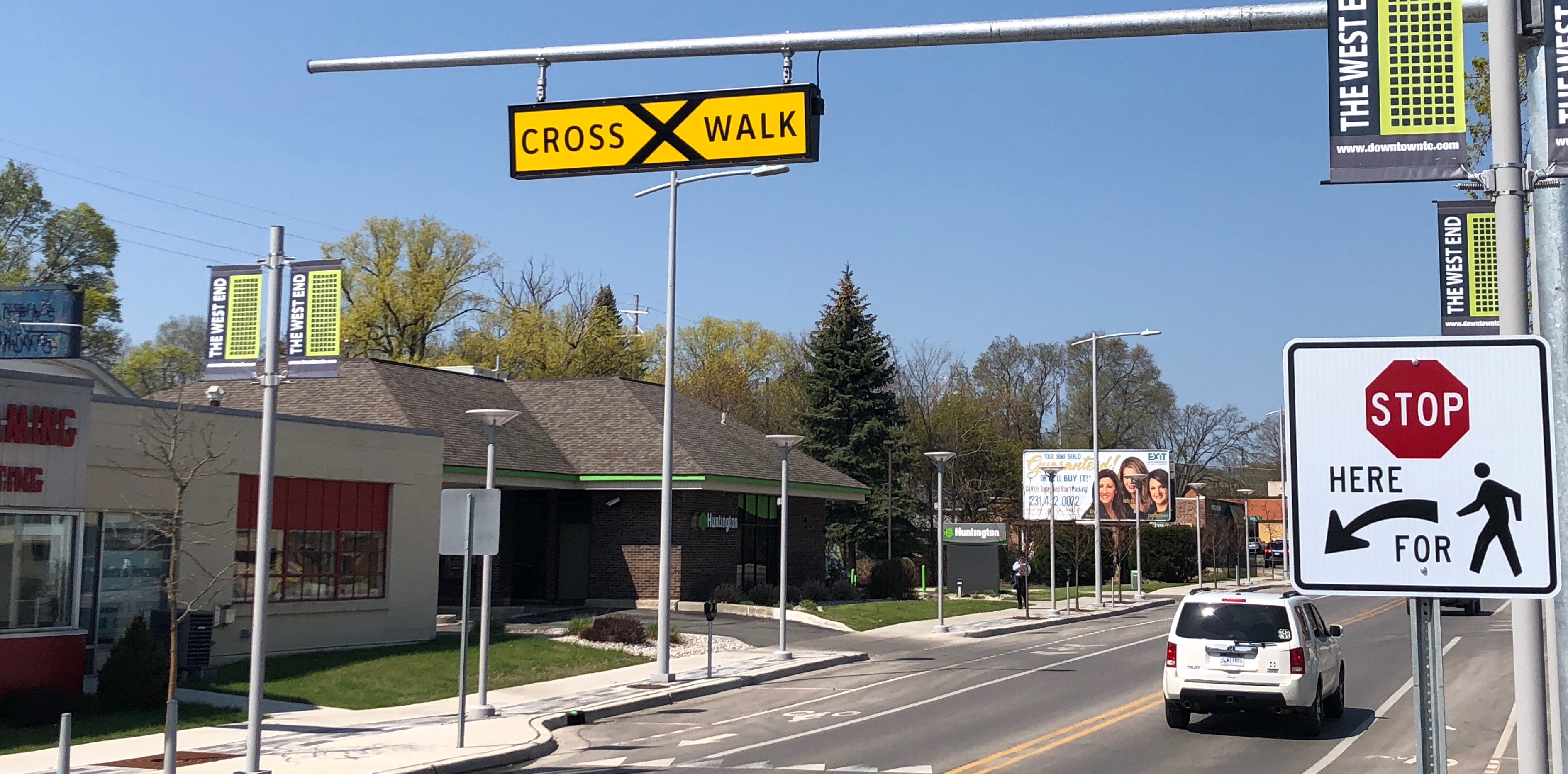
Crosswalks Key To Pedestrian-Friendly Plan Throughout City
By Craig Manning | May 21, 2018
Efforts are underway by the Traverse City Planning Commission to make Traverse City more pedestrian-friendly – a plan that emphasizes new crosswalks throughout the city.
According to Planning Director Russ Soyring, most of the improvements relate back to the “Complete Street” resolution that the Commission adopted in 2011. Part of the resolution was a local ordinance that required motorists to stop for pedestrians in marked crosswalks.
The ordinance led to the establishment of several new crosswalks throughout downtown Traverse City, situated in the middle of blocks and characterized by in-street “stop for pedestrian” signs. The goal was to make it easier for pedestrians to cross the street and navigate the downtown area. Early on, though, many wondered: Were they enforceable? And would drivers understand what they meant?
Soyring says the initial worries about the crosswalk signs have proved to be largely unjustified; the program, he believes, is thriving.
“Overall, these in-street signs have been extremely effective,” he says. “It seems like they are having an impact. They are highly visible, they are being noticed by motorists, and we’re getting extremely good compliance. Pedestrians seem to be able to cross more easily, and we’re getting a lot of supportive comments for these signs.”
Soyring does acknowledge that there is a bit of a learning curve to the crosswalks. Since the signs order drivers to “stop for pedestrians” rather than yield, some drivers have taken to treating the crosswalks like stop signs, even when no pedestrians are around. Drivers are allowed to go through the crosswalks without stopping if there are no pedestrians present. The city decided to substitute “yield” with “stop” because it’s easier to judge what constitutes a stop than what constitutes a yield, which Soyring says helps with both compliance and enforcement.
Aside from one accident early on in the program (an incident that actually involved a city commissioner) Soyring says the crosswalks have done a lot to keep downtown safer for pedestrians. The successes haven’t gone unnoticed, either. Elementary schools throughout the area have contacted the Planning Commission requesting in-street “stop for pedestrian” signs near their campuses. These installations dovetail with an initiative the Commission is pursuing to make walking to school a safer pursuit for kids.
“We have applied for the Safe Routes to School (SRTS) program,” Soyring says. “We’ve worked with the schools and we’ve worked with Norte and TART and other interested parties on developing this town to be a much more walkable area. We’re looking at where many of the students are located and how they might walk to school. We are going to be adding dozens of new marked crosswalks to the community in those areas.”
One of the biggest challenges for walkability and overall pedestrian access is Grandview Parkway. Soyring points to data that suggests motorists will stop for pedestrians if traffic is moving at less than 20 miles per hour. In the downtown area, the average traffic speed is 18 miles per hour, but on the Parkway, higher speed limits – and fewer stoplights or stop signs – result in faster traffic speeds. At the same time, crosswalks on the Parkway are fewer and further between, which Soyring says results in issues with jaywalking and reckless pedestrian behavior.
“We have this gorgeous waterfront on one side of the highway and a community on the other side, so it’s obvious that people are going to cross,” Soyring says. “Pedestrians aren’t going to walk a block out of their way to cross, so it’s extremely important to have frequent crosswalks and have them be very rewarding for pedestrians.”
Because the Parkway is part of M-22, a state trunkline, any improvements – including new crosswalks – fall under the purview of the state. Conversations between Soyring and Michigan Department of Transportation (MDOT) have resulted in a pilot program, launched last year, where MDOT started trying out in-street crosswalks not unlike the ones downtown.
Currently, there are three in-street crosswalks on Grandview Parkway: at Elmwood Avenue, Oak Street, and Hall Street. This year, MDOT is painting “yield lines” on the road to increase the visibility of the crosswalks.
“We are going to try this pilot out for two or three years, to see if there has been any impact in the number of crashes,” says Krista Phillips of MDOT's Traverse City Transportation Service Center.“Do they help pedestrians cross the street safer? Or are there unintended consequences, like rear-end crashes? We want to see what the overall perception is from both the pedestrian and the driver perspectives.”







